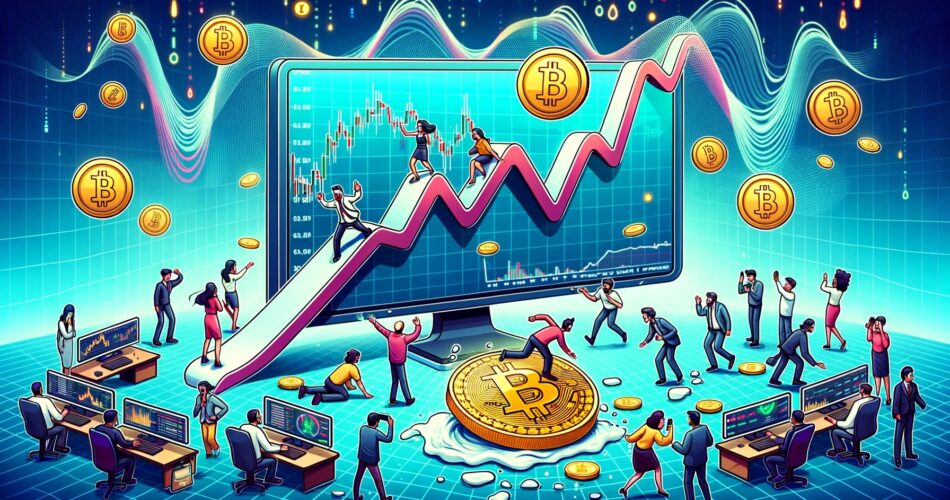The crypto market, with its allure of quick profits, has drawn in millions worldwide. But as traders dive into this digital gold rush, many overlook a crucial element: slippage. So, what is slippage in crypto? Let’s embark on a journey to demystify this term and arm you with the insights you need.
Table of Contents
Slippage Crypto Meaning
The Essence of Slippage
In the world of trading, whether it’s stocks, forex, or cryptocurrencies, the term “slippage” holds significant weight. At its most basic, slippage describes the phenomenon where the execution price of an order differs from the expected price. This difference can be minuscule or substantial, depending on various market factors.
Slippage in Traditional vs. Crypto Markets
While slippage is a concept that exists across all trading platforms, its implications in the crypto market are particularly pronounced. Traditional markets have set trading hours, and orders can be queued for execution at market open, which can lead to slippage if there’s a gap in prices. In contrast, the crypto market operates 24/7, and its volatile nature can cause prices to change rapidly, leading to more frequent and sometimes more significant slippage.
Positive vs. Negative Slippage
Slippage isn’t inherently negative. It can work in two ways:
Positive Slippage
This occurs when the execution price is better than the expected price. For instance, if a trader places a buy order expecting to purchase at $100, but the order gets executed at $98, they experience positive slippage.
Negative Slippage
This is when the execution price is worse than the expected price. Using the same example, if the trader’s buy order gets executed at $102 instead of the expected $100, they face negative slippage.
Causes of Slippage in Crypto
The crypto market, with its dynamic nature, is susceptible to slippage. Understanding the root causes can empower traders to navigate this landscape more effectively.
| Cause | Description | Impact on Slippage |
|---|---|---|
| Liquidity Issues | Refers to the ease of trading assets without major price changes. | Low liquidity can lead to higher chances of slippage. |
| Market Orders | Trades executed at the current market price. | Rapid price changes can cause significant slippage. |
| Volatility | The rate at which the price of an asset moves up or down. | High crypto volatility increases the risk of slippage. |
| Large Orders | Big buy or sell orders that can move the market. | Can exhaust available orders, leading to price shifts. |
By grasping the primary causes of slippage in the crypto market, traders can tailor their strategies to minimize its impact and optimize their trading outcomes.
Implications of Slippage for Traders
For traders, especially those in the fast-paced world of cryptocurrency, understanding the implications of slippage is paramount. Slippage can significantly influence trading outcomes, affecting both profitability and strategy.
Unexpected Losses: The Unseen Costs
Every trader enters the market with a set of expectations. Slippage, however, can introduce unforeseen costs. For instance, if a trader anticipates buying a cryptocurrency at $1,000 but due to slippage ends up purchasing at $1,050, that extra $50 represents an unexpected loss. These costs can accumulate over multiple trades, impacting overall profitability.
Stopped out on #BTC shorts. Price formed a $500 candle in 1 second, causing slippage on my trade. Had a terrible fill, haven't had slippage in a long time.
— Omz (@omzcharts) October 16, 2023
Risk was 0.04 BTC (including my adds), lost 0.073 BTC. I'm thankful my stop loss was tighter on my adds. Onto the next..🤝 pic.twitter.com/3ZETEqF0kw
Impact on Strategy: The Domino Effect
Trading strategies are often built on precise calculations and predictions. Slippage introduces an element of unpredictability, potentially throwing off these calculations. A strategy that doesn’t account for potential slippage might yield results different from expectations, necessitating adjustments or even complete overhauls.
Importance of Limit Orders: The Control Mechanism
Limit orders allow traders to specify the price at which they’re willing to buy or sell. By setting these boundaries, traders can exert more control over their trade execution prices, potentially reducing the impact of slippage. However, it’s worth noting that while limit orders can mitigate slippage, they don’t guarantee trade execution, especially in highly volatile markets.
| Implication | Description | Effect on Trading |
|---|---|---|
| Unexpected Losses | Costs incurred when the execution price differs from the expected price. | Can reduce profitability and require traders to adjust their budget or investment size for future trades. |
| Impact on Strategy | The unpredictability introduced by slippage can affect trading strategies. | Might necessitate strategy adjustments or overhauls to account for potential slippage. |
| Importance of Limit Orders | Limit orders allow traders to set specific buy or sell prices, offering a degree of protection against slippage. | While they can mitigate slippage, limit orders don’t guarantee trade execution in volatile markets. |
How to Minimize Slippage in Crypto Trading

Navigating the crypto market requires a blend of knowledge, strategy, and foresight. Slippage, while inherent in trading, can be minimized. Here’s how traders can reduce its impact and optimize their trading experience.
Choosing the Right Exchange: Your Trading Battleground
Liquidity is King
Selecting an exchange with high liquidity is paramount. High liquidity means there are ample buy and sell orders, reducing the price gaps that lead to slippage. Before committing to an exchange, research its trading volume and liquidity for the specific cryptocurrencies you’re interested in.
Reputation and Reliability
Beyond liquidity, the reputation of an exchange matters. Platforms known for their reliability and efficient order execution can help in reducing slippage. Always opt for exchanges that are well-regarded in the crypto community.
| Platform | Pros | Cons |
|---|---|---|
| MEXC | User-friendly interface, wide range of cryptocurrencies, lowest crypto exchange fees, advanced trading features | Platform may be complex for beginners, slow customer service response times |
| Binance | Large number of cryptocurrencies, advanced trading features, high liquidity, user-friendly interface | Reports of delayed customer service responses, potential target for hackers |
| Gate.io | Wide range of cryptocurrencies, advanced trading features, user-friendly interface, educational resources for beginners | Higher trading fees, does not support fiat currency deposits or withdrawals |
| OKX | Large number of cryptocurrencies, advanced trading features, competitive fees, user-friendly interface, educational resources for beginners | Reports of account freezes without prior notice, slow customer service response times |
| BingX | Advanced trading features, high leverage, ability to copy trades from successful traders, user-friendly interface | Smaller selection of cryptocurrencies, less liquidity due to smaller user base |
Trading During Peak Hours: Harnessing the Crowd
Understanding Market Timings
While the crypto market operates 24/7, there are peak hours when trading activity surges. These periods often align with daytime hours in major financial hubs like New York, London, or Tokyo. Trading during these hours can offer better liquidity, reducing slippage.
The Double-Edged Sword of Volatility
Peak hours can also bring increased volatility. While this means more trading opportunities, it’s essential to be cautious and use appropriate order types to manage slippage.
Using Stop-Limit Orders: Precision in Action
The Mechanics of Stop-Limit Orders
Stop-limit orders combine the features of stop orders and limit orders. A stop order triggers once a specific price is reached, while a limit order sets a maximum or minimum price for the trade. By combining these, traders can specify a price range, ensuring more control over execution prices.
When to Use Stop-Limit Orders
These orders are especially useful in volatile markets. By setting a range, traders can prevent their orders from executing at undesirable prices, thus minimizing slippage.
Avoiding Market Orders in Volatile Conditions: Treading with Caution
The Pitfalls of Market Orders
Market orders, while quick, execute at the best available price. In volatile conditions, this “best price” can change rapidly, leading to significant slippage.
Embracing Alternative Order Types
In times of high volatility, consider using limit or stop-limit orders. These provide more control over execution prices, helping traders avoid the worst effects of slippage.
Conclusion
The question “What is slippage in crypto?” is more than just a query about a technical term; it’s a gateway to understanding the intricate dynamics of the cryptocurrency trading world. Slippage, defined as the difference between the expected and executed price of a trade, might seem like a simple concept on the surface. However, as we’ve explored, its implications are vast and varied.
Navigating the crypto landscape requires not just knowledge of market trends but also an understanding of the underlying mechanisms, like slippage, that influence trading outcomes. From liquidity challenges to the unpredictability of market orders, various factors can lead to slippage. And while it’s an inherent aspect of trading, its impact can be managed and minimized with the right strategies and tools.
Through real-life examples, we’ve illuminated the tangible effects of slippage on traders’ experiences. These instances underscore the importance of being proactive, informed, and adaptable in the crypto realm.
In the ever-evolving world of cryptocurrency, where market dynamics can shift in the blink of an eye, understanding the answer to “What is slippage in crypto?” equips traders with valuable insights. It’s not just about recognizing a potential challenge but about harnessing knowledge to optimize trading decisions and outcomes.
In essence, as the crypto market continues its journey of growth and transformation, mastering foundational concepts like slippage will remain pivotal for traders aiming for success.
FAQs
Is slippage always bad?
No, slippage can sometimes work in a trader’s favor, leading to better-than-expected prices.
Can slippage be positive?
Absolutely! Positive slippage occurs when a trade is executed at a better price than expected.
How do different crypto exchanges handle slippage?
Different exchanges have varying liquidity and order types, which can influence the degree and frequency of slippage.


